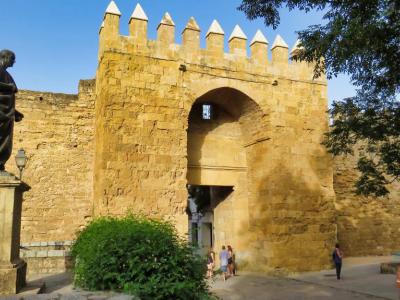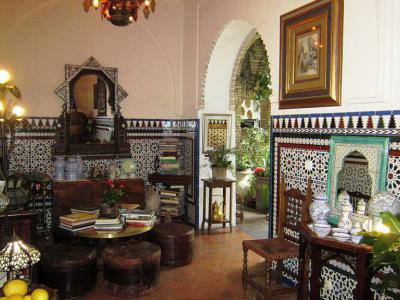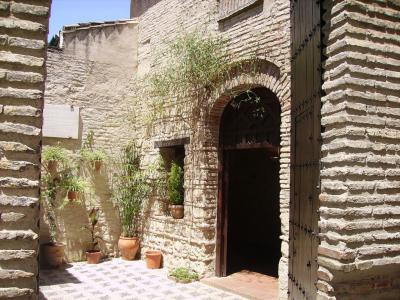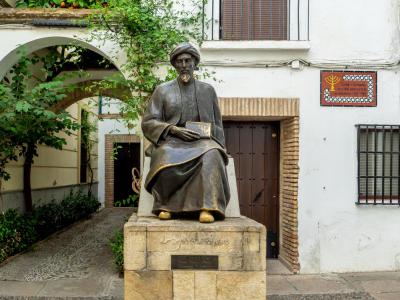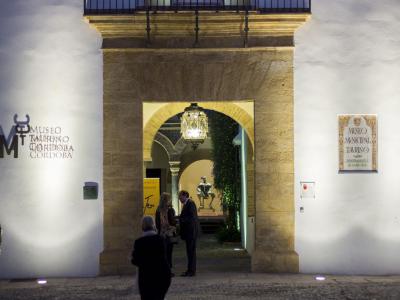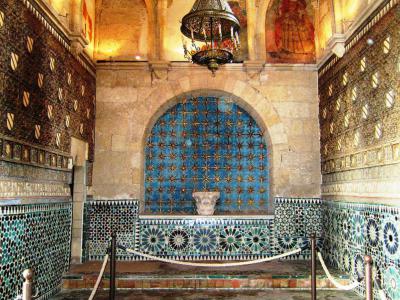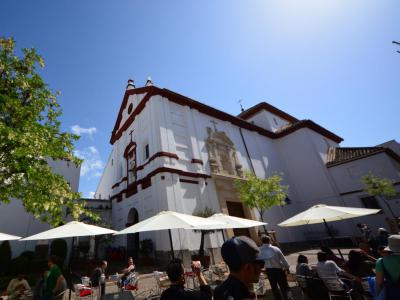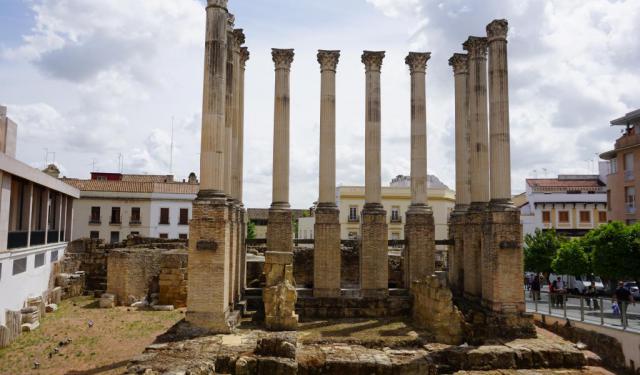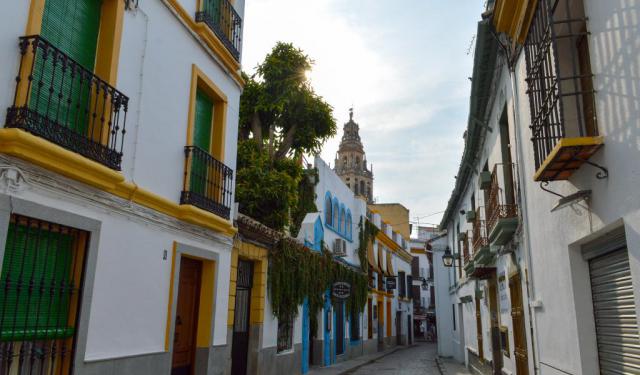
Cordoba Jewish Quarter Walk (Self Guided), Cordoba
The Judería de Córdoba is the area in Córdoba that was once densely populated by the Jews, between the 10th and the 15th centuries. Back then, it was a time when three world religions – Christianity, Judaism, and Islam – coexisted in Córdoba, although not always peacefully. Attesting to that today are the major religious shrines found in the area, like the Synagogue, the Mosque-Cathedral (first built as a mosque and then converted to a Catholic temple), and the Church of San Pedro de Alcantara.
Technically speaking, however, what is currently referred to as the Jewish Quarter – the district between Deanes, Manríquez, Tomás Conde, Judíos, Almanzor, and Romero streets – does not exactly correspond to the space inhabited by the Jews for most of that period. Nonetheless, as an integral part of the historic center of Córdoba (declared a World Heritage Site by UNESCO in 1994), this neighborhood is one of the most visited tourist destinations in the city.
Indeed, there's so much to see here. In addition to the museums like the Casa de Sefarad (House of Sefarad – dedicated to the Jewish culture), the Casa Andalusi (Andalusian House, home to the Alchemy Museum), and the Museo Taurino (the Municipal Bullfighting Museum), there are plenty of historical, cultural and architectural attractions to explore. Among them are the Zoco Municipal Souk (Market), the Puerta de Almodovar (Almodovar Gate – part of the walls that once marked the Jewish quarter boundary), and the 14th-century Mudejar chapel of San Bartolomé.
Walking through the Jewish Quarter, along the Calle de los Judíos (Jewish Street), you will find – in Plaza de Tiberias (aka Plaza de Maimonides) – a magnificent bronze statue dedicated to Maimónides, the great Jewish philosopher and medical doctor.
For a closer look at these and other sights, and a more detailed acquaintance with the Jewish heritage of Córdoba, take this self-guided walking tour.
Technically speaking, however, what is currently referred to as the Jewish Quarter – the district between Deanes, Manríquez, Tomás Conde, Judíos, Almanzor, and Romero streets – does not exactly correspond to the space inhabited by the Jews for most of that period. Nonetheless, as an integral part of the historic center of Córdoba (declared a World Heritage Site by UNESCO in 1994), this neighborhood is one of the most visited tourist destinations in the city.
Indeed, there's so much to see here. In addition to the museums like the Casa de Sefarad (House of Sefarad – dedicated to the Jewish culture), the Casa Andalusi (Andalusian House, home to the Alchemy Museum), and the Museo Taurino (the Municipal Bullfighting Museum), there are plenty of historical, cultural and architectural attractions to explore. Among them are the Zoco Municipal Souk (Market), the Puerta de Almodovar (Almodovar Gate – part of the walls that once marked the Jewish quarter boundary), and the 14th-century Mudejar chapel of San Bartolomé.
Walking through the Jewish Quarter, along the Calle de los Judíos (Jewish Street), you will find – in Plaza de Tiberias (aka Plaza de Maimonides) – a magnificent bronze statue dedicated to Maimónides, the great Jewish philosopher and medical doctor.
For a closer look at these and other sights, and a more detailed acquaintance with the Jewish heritage of Córdoba, take this self-guided walking tour.
How it works: Download the app "GPSmyCity: Walks in 1K+ Cities" from Apple App Store or Google Play Store to your mobile phone or tablet. The app turns your mobile device into a personal tour guide and its built-in GPS navigation functions guide you from one tour stop to next. The app works offline, so no data plan is needed when traveling abroad.
Cordoba Jewish Quarter Walk Map
Guide Name: Cordoba Jewish Quarter Walk
Guide Location: Spain » Cordoba (See other walking tours in Cordoba)
Guide Type: Self-guided Walking Tour (Sightseeing)
# of Attractions: 10
Tour Duration: 1 Hour(s)
Travel Distance: 0.4 Km or 0.2 Miles
Author: nataly
Sight(s) Featured in This Guide:
Guide Location: Spain » Cordoba (See other walking tours in Cordoba)
Guide Type: Self-guided Walking Tour (Sightseeing)
# of Attractions: 10
Tour Duration: 1 Hour(s)
Travel Distance: 0.4 Km or 0.2 Miles
Author: nataly
Sight(s) Featured in This Guide:
- Puerta de Almodovar (Almodovar Gate)
- Casa Andalusi (Andalusian House Museum)
- Casa de Sefarad (House of Sefarad)
- Sinagoga de Cordoba (Cordoba Synagogue)
- Maimónides Square and Statue
- Museo Taurino (Bullfighting Museum)
- Capilla Mudejar de San Bartolome (Chapel of St. Bartolome)
- El Zoco Municipal Souk
- Plaza del Cardenal Salazar (Cardenal Salazar Square)
- Iglesia de San Pedro de Alcantara (Church of St. Peter of Alcantara)
1) Puerta de Almodovar (Almodovar Gate)
The Almodovar Gate (Puerta de Almodovar) is a city gate along Cordoba's old town walls. In its current state, the Almodovar Gate dates from the 14th century and is one of three gates that remain from the medieval city walls. The Almodovar Gate received its name from its connection to the nearby town of Almodóvar del Río via an old road.
The gate is a sandstone masonry and brick structure featuring a large open archway flanked by two towers topped with battlements. It offers an entryway into and out of the city's medieval Jewish quarter and its charming maze of narrow cobblestoned alleyways.
Cairuan Street (Calle Cairuán) is a picturesque stone walkway that runs parallel the outside of the old city walls and the Almodovar Gate. This walkway offers a pleasant place to stroll, with greenery and a fountain that peacefully flows into a row of rectangular ponds.
Don't miss to look at the bronze statue of Seneca the Younger that stands directly outside the gate. Born in Cordoba in 4 B.C., Seneca became famous as a playwright and philosopher in ancient Rome. A walk along Cairuan Street will take you to a second statue outside the wall. This statue honors Averroes, another philosopher born in Cordoba.
The gate is a sandstone masonry and brick structure featuring a large open archway flanked by two towers topped with battlements. It offers an entryway into and out of the city's medieval Jewish quarter and its charming maze of narrow cobblestoned alleyways.
Cairuan Street (Calle Cairuán) is a picturesque stone walkway that runs parallel the outside of the old city walls and the Almodovar Gate. This walkway offers a pleasant place to stroll, with greenery and a fountain that peacefully flows into a row of rectangular ponds.
Don't miss to look at the bronze statue of Seneca the Younger that stands directly outside the gate. Born in Cordoba in 4 B.C., Seneca became famous as a playwright and philosopher in ancient Rome. A walk along Cairuan Street will take you to a second statue outside the wall. This statue honors Averroes, another philosopher born in Cordoba.
2) Casa Andalusi (Andalusian House Museum)
In the heart of Cordoba's Jewish Quarter, stays Andalusian House (Casa Andalusi), a small and charming 12th-century house surrounding a central courtyard. The building is located near the Cordoba Synagogue and not far from the Almodovar Gate.
Today, this historic house hosts a museum featuring a variety of exhibits relating to traditional Andalusian home life during medieval times. Visitors can explore rooms filled with exquisite furnishing, tapestries, paintings, books, artifacts, and household goods. The art and architecture of the house are Moorish-style with some Eastern influence.
The museum features some walls and alcoves beautifully decorated with mosaic tiles. The outdoor courtyard is gorgeous. The decorative cobblestone patio is inviting, surrounded by arcaded porches, small fountains, and lush greenery. Potted plants and climbing vines create a lovely sanctuary. Head down to the basement to see an excavated Roman floor and ancient ruins below the house.
Andalusian House is also home to the Paper Museum (Museo del Papel ), offering a fascinating exploration into the techniques and history of early paper making. A unique scale model made of wood demonstrates the workings of one of the Western world's earliest paper factories.
Today, this historic house hosts a museum featuring a variety of exhibits relating to traditional Andalusian home life during medieval times. Visitors can explore rooms filled with exquisite furnishing, tapestries, paintings, books, artifacts, and household goods. The art and architecture of the house are Moorish-style with some Eastern influence.
The museum features some walls and alcoves beautifully decorated with mosaic tiles. The outdoor courtyard is gorgeous. The decorative cobblestone patio is inviting, surrounded by arcaded porches, small fountains, and lush greenery. Potted plants and climbing vines create a lovely sanctuary. Head down to the basement to see an excavated Roman floor and ancient ruins below the house.
Andalusian House is also home to the Paper Museum (Museo del Papel ), offering a fascinating exploration into the techniques and history of early paper making. A unique scale model made of wood demonstrates the workings of one of the Western world's earliest paper factories.
3) Casa de Sefarad (House of Sefarad)
Tucked in the narrow alleyways of Cordoba's Jewish Quarter is an old 14th-century house called the House of Sefarad (Sepharad is the Hebrew name for Spain). At one time, it connected to the neighboring Synagogue via an underground tunnel. Today, the building serves as a Jewish heritage museum filled with exhibits documenting Jewish history and culture in Spain. The House of Sefarad (Casa de Sefarad) is also known as the "House of Memory."
Inside the museum, you'll find displays offering an eclectic array of historical clothing, jewelry, ceramics, artwork, religious relics, and artifacts. The museum is comprised of several rooms that surround a central courtyard. Each room focuses on a theme, including domestic life, music, religious customs, festivals, and language.
One of the rooms is dedicated to five dominant women of the historical kingdom Al-Andalus (the Muslim-ruled area of Spain). Another room of the museum focuses on the persecution of the Jewish people during the Spanish Inquisition, featuring documents and other artifacts. There is also a space dedicated to the life of Maimonides, a Sephardic Jewish philosopher born in Cordoba.
Don't miss spending a little time in the beautiful central courtyard. There are arcaded porches, balconies, and vine-covered colonnaded walkways along the sides. The pebble mosaic floor of the patio features a striking design with a Star of David in the center. Sometimes music is performed in the courtyard.
Inside the museum, you'll find displays offering an eclectic array of historical clothing, jewelry, ceramics, artwork, religious relics, and artifacts. The museum is comprised of several rooms that surround a central courtyard. Each room focuses on a theme, including domestic life, music, religious customs, festivals, and language.
One of the rooms is dedicated to five dominant women of the historical kingdom Al-Andalus (the Muslim-ruled area of Spain). Another room of the museum focuses on the persecution of the Jewish people during the Spanish Inquisition, featuring documents and other artifacts. There is also a space dedicated to the life of Maimonides, a Sephardic Jewish philosopher born in Cordoba.
Don't miss spending a little time in the beautiful central courtyard. There are arcaded porches, balconies, and vine-covered colonnaded walkways along the sides. The pebble mosaic floor of the patio features a striking design with a Star of David in the center. Sometimes music is performed in the courtyard.
4) Sinagoga de Cordoba (Cordoba Synagogue)
The historic Cordoba Synagogue (Sinagoga de Cordoba), situated along a narrow street in the Jewish Quarter of Cordoba, dates from the early 14th century. Small yet significant, it is one of the most well-preserved synagogues in Spain. Based on its modest size, the synagogue may have been a private temple for an affluent family.
The structure features Moorish architecture. Inside is an entrance hall, a prayer hall, and an upper gallery for women. The front gate enters into a tiny walled courtyard with potted plants and a mosaic floor. A stairway at the side of the entrance hall leads up to the women's balcony.
The stunning prayer room is the highlight of a visit to the synagogue. The small room features a noticeably high ceiling. The ornate stucco walls are detailed with intricately carved latticework patterns and Hebrew inscriptions. There is a niche on either side of the room. One contains a menorah, though housing Torah scrolls was its original use.
Through ornamental open archways near the top of the prayer room are views into the women's section. Latticework was, at one time, located at the bottom part of the arches to act as a privacy screen. The synagogue's highly decorative vaulted ceiling is created from wood panels and beams.
A stop to visit this beautiful synagogue is a must-do on your tour of Cordoba's Jewish Quarter.
The structure features Moorish architecture. Inside is an entrance hall, a prayer hall, and an upper gallery for women. The front gate enters into a tiny walled courtyard with potted plants and a mosaic floor. A stairway at the side of the entrance hall leads up to the women's balcony.
The stunning prayer room is the highlight of a visit to the synagogue. The small room features a noticeably high ceiling. The ornate stucco walls are detailed with intricately carved latticework patterns and Hebrew inscriptions. There is a niche on either side of the room. One contains a menorah, though housing Torah scrolls was its original use.
Through ornamental open archways near the top of the prayer room are views into the women's section. Latticework was, at one time, located at the bottom part of the arches to act as a privacy screen. The synagogue's highly decorative vaulted ceiling is created from wood panels and beams.
A stop to visit this beautiful synagogue is a must-do on your tour of Cordoba's Jewish Quarter.
5) Maimónides Square and Statue
Maimónides Square (Plaza de Maimónides) is located in the central part of the Jewish Quarter of Cordoba. The square is named for the Sephardic Jewish philosopher born in Cordoba during the 12th century. His full name is Moses ben Maimon, but he is more frequently known as Maimónides. He was a physician, an astronomer, a great thinker, and an influential scholar famous for his philosophical writings.
On a pedestal in the center of a small nearby courtyard known as Tiberias Square (Plaza de Tiberíades) stands a monument to Maimónides. This bronze statue was erected in 1964 and is the creation of the accomplished Spanish sculptor Amadeo Olmos Ruiz. Legend has it that touching the feet of Maimónides on the sculpture will bring you good luck.
There is plenty to explore around this area. On Maimónides Square is the Bullfighting Museum of Cordoba (Museo Taurino), showcasing the history and art of the bullfight. The museum also spotlights some of the legendary matadors of Cordoba. You'll also find a luxury hotel situated along one side of the square.
You'll want to visit the nearby museum House of Sefarad (Casa de Sefarad) with an exhibition room devoted to the life of Maimónides.
On a pedestal in the center of a small nearby courtyard known as Tiberias Square (Plaza de Tiberíades) stands a monument to Maimónides. This bronze statue was erected in 1964 and is the creation of the accomplished Spanish sculptor Amadeo Olmos Ruiz. Legend has it that touching the feet of Maimónides on the sculpture will bring you good luck.
There is plenty to explore around this area. On Maimónides Square is the Bullfighting Museum of Cordoba (Museo Taurino), showcasing the history and art of the bullfight. The museum also spotlights some of the legendary matadors of Cordoba. You'll also find a luxury hotel situated along one side of the square.
You'll want to visit the nearby museum House of Sefarad (Casa de Sefarad) with an exhibition room devoted to the life of Maimónides.
6) Museo Taurino (Bullfighting Museum)
The Bullfighting Museum (Museo Taurino) is a specialty museum dedicated to bullfighting and the famous matadors of Spain. Situated on Maimónides Square in the Jewish Quarter, the museum is housed inside a 16th-century Spanish-style mansion called House of the Bulls (Casa de las Bulas).
The museum offers multiple exhibition halls to explore, where visitors can learn about the history and tradition of bullfighting. A wide array of art and artifacts is on display. There are matador costumes, paintings, sculptures, pottery, hand-painted crockery with bullfighting motifs, mounted bull's heads, archival photographs, plus colorful vintage posters of bullfighting and fiestas.
One room pays tribute to the "Five Caliphs," the most famous bullfighters born in Cordoba. One of them was Manolete, a famous matador, one of the greatest bullfighters of all time, killed in the bullring in 1947 at only 30 years old. The museum features elaborate original costumes and photographs of these well-known figures in the world of bullfighting.
There are audiovisual introductions available to help give museum visitors insight into the art of the bullfight. The museum's entrance gate leads into a picturesque courtyard boasting an arcaded porch, a tranquil garden, a matador bust, and a prominently placed bull statue. The bull offers a popular photo spot for tourists.
The museum offers multiple exhibition halls to explore, where visitors can learn about the history and tradition of bullfighting. A wide array of art and artifacts is on display. There are matador costumes, paintings, sculptures, pottery, hand-painted crockery with bullfighting motifs, mounted bull's heads, archival photographs, plus colorful vintage posters of bullfighting and fiestas.
One room pays tribute to the "Five Caliphs," the most famous bullfighters born in Cordoba. One of them was Manolete, a famous matador, one of the greatest bullfighters of all time, killed in the bullring in 1947 at only 30 years old. The museum features elaborate original costumes and photographs of these well-known figures in the world of bullfighting.
There are audiovisual introductions available to help give museum visitors insight into the art of the bullfight. The museum's entrance gate leads into a picturesque courtyard boasting an arcaded porch, a tranquil garden, a matador bust, and a prominently placed bull statue. The bull offers a popular photo spot for tourists.
7) Capilla Mudejar de San Bartolome (Chapel of St. Bartolome)
The Chapel of Saint Bartolome (Capilla Mudejar de San Bartolome) is a stunning historic monument in Cordoba. It dates from the late 14th and early 15th century and offers a superb illustration of Mudejar architecture. The Mudejar style is a fusion that combines traditional Islamic decorative patterns and motifs with Christian and Moorish architecture.
The intimate chapel is richly decorated and exquisite; the walls are highly ornamental in their design and embellishment. Along the base of the walls are some lovely inlaid mosaic tiles in shades of blue and green. The room includes a beautiful arched niche and ornate light fixtures that hang from the vaulted ceiling. The original flooring is preserved, along with remnants of frescoes at the ceiling's base.
Before you enter this small chapel, you'll find a picturesque little courtyard with a three-arch portico and columns. A tall palm tree stands in the middle of the courtyard's patio – a spot decoratively paved using small stones.
The Chapel of San Bartolome has been listed as a historical monument since 1931. A stop to visit this chapel is a must-do on your tour through Cordoba's Jewish Quarter.
The intimate chapel is richly decorated and exquisite; the walls are highly ornamental in their design and embellishment. Along the base of the walls are some lovely inlaid mosaic tiles in shades of blue and green. The room includes a beautiful arched niche and ornate light fixtures that hang from the vaulted ceiling. The original flooring is preserved, along with remnants of frescoes at the ceiling's base.
Before you enter this small chapel, you'll find a picturesque little courtyard with a three-arch portico and columns. A tall palm tree stands in the middle of the courtyard's patio – a spot decoratively paved using small stones.
The Chapel of San Bartolome has been listed as a historical monument since 1931. A stop to visit this chapel is a must-do on your tour through Cordoba's Jewish Quarter.
8) El Zoco Municipal Souk
A souk is defined as an Arab marketplace or open-air bazaar. Down a narrow street in Cordoba's Jewish Quarter, you'll find the El Zoco Municipal Souk, a lovely marketplace offering local artisan crafts for sale. It is located at a historic manor house boasting eye-catching Spanish-style architecture.
Step off the street into a beautiful courtyard situated at El Zoco's center. Small stones pave the courtyard's gorgeous outdoor patio. Surrounding it are two levels of arcaded walkways and a stairway up to the second floor. A delightful display of plants and flowers in blue pots adds color to the building's whitewashed walls and wrought-iron balcony railings.
This craft market features a collection of small workshops where artisans sell their wares. The shops are situated on both levels inside the building that surrounds the courtyard. Leather goods, artwork, hand-painted tiles, ceramics, and jewelry are just some of the unique handicrafts available to buy.
The El Zoco marketplace is a great place to stop, relax, and do some shopping during your tour around Cordoba. On occasion, you can even hear live music performances in the outdoor courtyard.
Step off the street into a beautiful courtyard situated at El Zoco's center. Small stones pave the courtyard's gorgeous outdoor patio. Surrounding it are two levels of arcaded walkways and a stairway up to the second floor. A delightful display of plants and flowers in blue pots adds color to the building's whitewashed walls and wrought-iron balcony railings.
This craft market features a collection of small workshops where artisans sell their wares. The shops are situated on both levels inside the building that surrounds the courtyard. Leather goods, artwork, hand-painted tiles, ceramics, and jewelry are just some of the unique handicrafts available to buy.
The El Zoco marketplace is a great place to stop, relax, and do some shopping during your tour around Cordoba. On occasion, you can even hear live music performances in the outdoor courtyard.
9) Plaza del Cardenal Salazar (Cardenal Salazar Square)
Named after Cardinal Salazar, the Plaza del Cardenal Salazar (Cardenal Salazar Square) is an attractive place in the Jewish Quarter. Cardinal Salazar (Pedro de Salazar Gutiérrez de Toledo) served as the bishop of Cordoba for almost 20 years, from 1686 until he died in 1706.
In the early 18th century, he founded the Cardinal Salazar Hospital (Hospital del Cardenal Salazar) after a plague epidemic ravaged the city of Cordoba. The building, located on Cardenal Salazar Square, originated in helping both the sick and the homeless. For many years it became a hospital for the terminally ill. Today, this building houses the Faculty of Philosophy and Letters for the University of Cordoba.
Another prominent building along this square is the Church of San Pedro de Alcantara. Inaugurated by Cardinal Salazar, this is a gorgeous historic structure. You can't miss seeing this lovely church on your tour around Cordoba. Around the square and along the nearby alleyways are several vibrant restaurants that are certainly worth checking out.
In the early 18th century, he founded the Cardinal Salazar Hospital (Hospital del Cardenal Salazar) after a plague epidemic ravaged the city of Cordoba. The building, located on Cardenal Salazar Square, originated in helping both the sick and the homeless. For many years it became a hospital for the terminally ill. Today, this building houses the Faculty of Philosophy and Letters for the University of Cordoba.
Another prominent building along this square is the Church of San Pedro de Alcantara. Inaugurated by Cardinal Salazar, this is a gorgeous historic structure. You can't miss seeing this lovely church on your tour around Cordoba. Around the square and along the nearby alleyways are several vibrant restaurants that are certainly worth checking out.
10) Iglesia de San Pedro de Alcantara (Church of St. Peter of Alcantara)
Situated on Cardenal Salazar Square, the Iglesia de San Pedro de Alcantara (Church of Saint Peter of Alcantara) is a beautiful Catholic edifice completed in 1696. It was inaugurated by Cardinal Salazar, the bishop of Cordoba. He served as bishop during the later years of the 17th century and up to 1706, the year of his death.
The lovely interior of the church features a single nave and a transept that forms a cross. The gorgeous main altarpiece, executed in marble, is the work of renowned Spanish architect Francisco Hurtado Izquierdo. At one point, the building also served as a convent occupied by nuns. Stunning ceiling murals decorate the dome of the church.
The church was, in recent years, restored to its original facade of white paint with red ornamental molding and roof. Be sure to make a stop at this historic church on your tour through the Jewish Quarter of Cordoba.
The lovely interior of the church features a single nave and a transept that forms a cross. The gorgeous main altarpiece, executed in marble, is the work of renowned Spanish architect Francisco Hurtado Izquierdo. At one point, the building also served as a convent occupied by nuns. Stunning ceiling murals decorate the dome of the church.
The church was, in recent years, restored to its original facade of white paint with red ornamental molding and roof. Be sure to make a stop at this historic church on your tour through the Jewish Quarter of Cordoba.
Walking Tours in Cordoba, Spain
Create Your Own Walk in Cordoba
Creating your own self-guided walk in Cordoba is easy and fun. Choose the city attractions that you want to see and a walk route map will be created just for you. You can even set your hotel as the start point of the walk.
Cordoba Introduction Walking Tour
It is said that the Carthaginian general, Hamilcar Barca, named the town Qart Juba which means "Town of Juba," for a comrade general killed in battle. Roman conquerors pronounced the name "Corduba." Close enough.
A Carthaginian settlement on the West Bank of the Guadalquivir River was captured by the Romans in 206 BC. A proper Roman colony was founded near the Iberian... view more
Tour Duration: 2 Hour(s)
Travel Distance: 3.3 Km or 2.1 Miles
A Carthaginian settlement on the West Bank of the Guadalquivir River was captured by the Romans in 206 BC. A proper Roman colony was founded near the Iberian... view more
Tour Duration: 2 Hour(s)
Travel Distance: 3.3 Km or 2.1 Miles
Ancient Roman Sites Walking Tour
Under all in Cordoba lies a once redoubtable Roman strongpoint. After Scipio's defeat of the Carthaginians in Llipa, the victorious Romans set up camp by the Guadalquivir River.
Under Augustus, the city gained the status of Colonia Patricia. A perimeter wall was built touching the Guadalquivir River. There were two forums, colonial and provincial. A large amphitheater has been uncovered.... view more
Tour Duration: 1 Hour(s)
Travel Distance: 2.5 Km or 1.6 Miles
Under Augustus, the city gained the status of Colonia Patricia. A perimeter wall was built touching the Guadalquivir River. There were two forums, colonial and provincial. A large amphitheater has been uncovered.... view more
Tour Duration: 1 Hour(s)
Travel Distance: 2.5 Km or 1.6 Miles
The Most Popular Cities
/ view all
